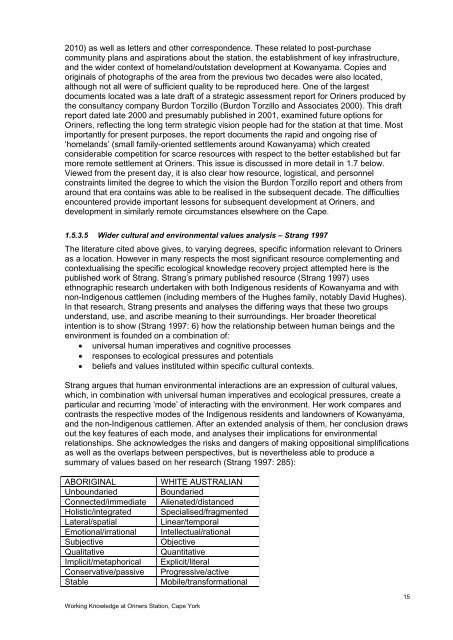WfHC - cover page (not to be used with pre-printed report ... - CSIRO
WfHC - cover page (not to be used with pre-printed report ... - CSIRO
WfHC - cover page (not to be used with pre-printed report ... - CSIRO
You also want an ePaper? Increase the reach of your titles
YUMPU automatically turns print PDFs into web optimized ePapers that Google loves.
2010) as well as letters and other correspondence. These related <strong>to</strong> post-purchase<br />
community plans and aspirations about the station, the establishment of key infrastructure,<br />
and the wider context of homeland/outstation development at Kowanyama. Copies and<br />
originals of pho<strong>to</strong>graphs of the area from the <strong>pre</strong>vious two decades were also located,<br />
although <strong>not</strong> all were of sufficient quality <strong>to</strong> <strong>be</strong> reproduced here. One of the largest<br />
documents located was a late draft of a strategic assessment <strong>report</strong> for Oriners produced by<br />
the consultancy company Burdon Torzillo (Burdon Torzillo and Associates 2000). This draft<br />
<strong>report</strong> dated late 2000 and <strong>pre</strong>sumably published in 2001, examined future options for<br />
Oriners, reflecting the long term strategic vision people had for the station at that time. Most<br />
importantly for <strong>pre</strong>sent purposes, the <strong>report</strong> documents the rapid and ongoing rise of<br />
„homelands‟ (small family-oriented settlements around Kowanyama) which created<br />
considerable competition for scarce resources <strong>with</strong> respect <strong>to</strong> the <strong>be</strong>tter established but far<br />
more remote settlement at Oriners. This issue is discussed in more detail in 1.7 <strong>be</strong>low.<br />
Viewed from the <strong>pre</strong>sent day, it is also clear how resource, logistical, and personnel<br />
constraints limited the degree <strong>to</strong> which the vision the Burdon Torzillo <strong>report</strong> and others from<br />
around that era contains was able <strong>to</strong> <strong>be</strong> realised in the subsequent decade. The difficulties<br />
encountered provide important lessons for subsequent development at Oriners, and<br />
development in similarly remote circumstances elsewhere on the Cape.<br />
1.5.3.5 Wider cultural and environmental values analysis – Strang 1997<br />
The literature cited above gives, <strong>to</strong> varying degrees, specific information relevant <strong>to</strong> Oriners<br />
as a location. However in many respects the most significant resource complementing and<br />
contextualising the specific ecological knowledge re<strong>cover</strong>y project attempted here is the<br />
published work of Strang. Strang‟s primary published resource (Strang 1997) uses<br />
ethnographic research undertaken <strong>with</strong> both Indigenous residents of Kowanyama and <strong>with</strong><br />
non-Indigenous cattlemen (including mem<strong>be</strong>rs of the Hughes family, <strong>not</strong>ably David Hughes).<br />
In that research, Strang <strong>pre</strong>sents and analyses the differing ways that these two groups<br />
understand, use, and ascri<strong>be</strong> meaning <strong>to</strong> their surroundings. Her broader theoretical<br />
intention is <strong>to</strong> show (Strang 1997: 6) how the relationship <strong>be</strong>tween human <strong>be</strong>ings and the<br />
environment is founded on a combination of:<br />
universal human imperatives and cognitive processes<br />
responses <strong>to</strong> ecological <strong>pre</strong>ssures and potentials<br />
<strong>be</strong>liefs and values instituted <strong>with</strong>in specific cultural contexts.<br />
Strang argues that human environmental interactions are an ex<strong>pre</strong>ssion of cultural values,<br />
which, in combination <strong>with</strong> universal human imperatives and ecological <strong>pre</strong>ssures, create a<br />
particular and recurring „mode‟ of interacting <strong>with</strong> the environment. Her work compares and<br />
contrasts the respective modes of the Indigenous residents and landowners of Kowanyama,<br />
and the non-Indigenous cattlemen. After an extended analysis of them, her conclusion draws<br />
out the key features of each mode, and analyses their implications for environmental<br />
relationships. She acknowledges the risks and dangers of making oppositional simplifications<br />
as well as the overlaps <strong>be</strong>tween perspectives, but is nevertheless able <strong>to</strong> produce a<br />
summary of values based on her research (Strang 1997: 285):<br />
ABORIGINAL WHITE AUSTRALIAN<br />
Unboundaried Boundaried<br />
Connected/immediate Alienated/distanced<br />
Holistic/integrated Specialised/fragmented<br />
Lateral/spatial Linear/temporal<br />
Emotional/irrational Intellectual/rational<br />
Subjective Objective<br />
Qualitative Quantitative<br />
Implicit/metaphorical Explicit/literal<br />
Conservative/passive Progressive/active<br />
Stable Mobile/transformational<br />
Working Knowledge at Oriners Station, Cape York<br />
15
















